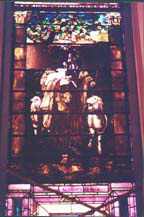The president of a local historical group was recently apprised that the stained glass windows in a church on Bergen Avenue may have artistic and historical significance.
The windows in the Cotton Temple Church of God in Christ on Bergen Avenue may have been created by Tiffany-trained artist Benjamin Sellers, according to John Gomez, president of the Jersey City Landmarks Conservancy. Gomez had received correspondence from a relative of Sellers’ apprising him of their possible significance.
"You could call it the School of Tiffany since Sellers worked for the Louis Tiffany’s glass company when it had a manufacturing location in Jersey City," Gomez said.
Louis Tiffany’s glass manufacturing company started in the early 1870s in partnership with artist John Lafarge. Starting out in Brooklyn and later branching out to Jersey City, Tiffany created decorative stained glass windows, lamps, furniture and jewelry that are in many museums today and are highly valued by collectors.
"Sellers came to America from England in 1882," said David Todd, a descendant of Sellers who has collected information on the artist. Todd lives in upstate New York and has been corresponding with Gomez. "The earliest church that I know of that has his windows in it was built in 1892," Todd said. "That would make a 10-year period with Tiffany between 1882 and 1892."
After 1892, Sellers started his own firm, Benjamin Sellers & Sons, which competed with Tiffany in the thriving market for decorative stained glass, according to Todd.
John Gomez believes Sellers created the windows in Cotton Temple, formerly South Bergen Reformed Church, when it was built in 1892, because of letters Seller’s descendants have.
"The letter is from the congregation of South Bergen Reformed thanking Sellers for the work he did on the windows," said Gomez. "We have been exchanging e-mails and photos with Sellers’ family in England which how we found out about the glass at Cotton Temple."
"We were astonished by the things we were told about our windows," said Cotton Temple’s associate, Elder Mario Moody. "We knew they were very old, but not that old."
Cotton Temple has been a Pentecostal Holiness Church since 1976, Moody said, and has a congregation of approximately 400 people. There are 20 windows in the church: three by the alter depicting Christ, seven windows with religious symbols, two rose windows, and eight panels depicting The Last Supper.
"Most of the windows are protected right now with Plexiglas," said Moody, adding that wire mesh covered the stained glass windows to protect them from vandalism.
Damage from rain and condensation has also been a problem for the windows at Cotton Temple, and at least one of the windows, portraying Christ as a shepherd, has been restored.
"That was done in 1997 and cost about $10,000," said Moody. "We would like to restore the others, but we can’t right now because of the cost."
Barbara Meise, a professional stained glass restorer from Jersey City who worked on the "Christ the Shepherd," sees the windows as more an independent creation of Sellers as opposed to him working in the style of Tiffany.
Her main argument hinges on the glass itself. According to Meise, Tiffany used a glass of his own design called Favrile, and Tiffany kept the formula for the glass a secret. The glass in windows at Cotton Temple, Meise said, are not Favrile.
"Those windows are double glazed," said Meise, explaining the Cotton Temple stained glass has two layers of glass, while Tiffany only used one.
Gomez argues for the School of Tiffany designation by noting the design similarities to signature Tiffany windows.
"Like Tiffany’s work, the windows at Cotton Temple have a lot of blues and purples," Gomez said. "There is a lot of landscape in the background of the windows, which was a Tiffany trait."
Meise believes Sellers took his inspiration for "Christ the Shepherd" not so much from Tiffany, but a contemporary British painter, William H. Hunt. Hunt was a member of the Pre-Raphealite movement, which often dealt in religious themes.
"The window looks a great deal like the Hunt painting," Meise said.
Meise suspects that when Sellers was doing the designs for the window, known as cartoons, he incorporated the Hunt painting. Cartoons are charcoal drawings of the windows, with each piece of window numbered on the cartoon. When the windows are being put together or reassembled after cleaning, the pieces can be fitted together correctly.
Despite any argument over the windows’ design, Moody and his congregation are still glad to have them in their church.
"You don’t realize the value of what you have until someone shows it to you," commented Moody.
The church is located at 388 Bergen Ave.
